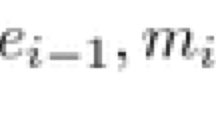Abstract
Why should coherence be an epistemic desideratum? One response is that coherence is truth-conducive: mutually coherent propositions are more likely to be true, ceteris paribus, than mutually incoherent ones. But some sets of propositions are more coherent, while others are less so. How could coherence be measured? Probabilistic measures of coherence exist; some are identical to probabilistic measures of confirmation, while others are extensions of such measures. Probabilistic measures of coherence are fine when applicable, but many situations are so information-poor that the requisite probabilities cannot be determined. To measure coherence in these cognitively impoverished situations, this article proposes that the discussion be broadened to include plausibilistic measures of coherence. It shows how plausibilistic measures of coherence can be defined using plausibilistic measures of confirmation. It then illustrates how plausibilisic coherence can be measured in situations where probabilistic coherence cannot be determined. The coherence values obtained through the use of plausibilistic measures are often, though not always, comparable. The article also shows that coherence can be instantiated on different levels, one of which permits connections to inductive strength and deductive validity.
Similar content being viewed by others
Notes
I have adapted Chu and Halpern’s set-theoretic statement to the propositional idiom.
Terminology varies. Bovens and Hartmann actually use the term ‘quasi-ordering’ to describe a relation that is reflexive, transitive, but not necessarily complete (2003, p. 25).
This restriction is inessential. Logically equivalent and contradictory propositions could be included by stipulating that the conditional plausibility of equivalents is the maximal value \(\top \) and that of contradictories is the minimal value \(\bot \).
I am greatly indebted to an anonymous reviewer for this point.
References
Angere, S. (2007). The defeasible nature of coherentist justification. Synthese, 157, 321–335.
Angere, S. (2008). Coherence as a heuristic. Mind, 117, 1–26.
Atkinson, D., Peijnenburg, J., & Kuipers, T. (2009). How to confirm the conjunction of disconfirmed hypotheses. Philosophy of Science, 87, 1–21.
Bovens, L., & Hartmann, S. (2003). Bayesian epistemology. Oxford: Oxford University Press.
Carnap, R. (1962). Logical foundations of probability (2nd ed.). Chicago: University of Chicago Press.
Chu, F. C., & Halpern, J. Y. (2004). Great expectations. Part II: Generalized expected utility as a universal decision rule. Artificial Intelligence, 159, 207–229.
Dewey, J. (1910). How we think. Lexington: D.C. Heath.
Dietrich, F., & Moretti, L. (2005). On coherent sets and the transmission of confirmation. Philosophy of Science, 72, 403–424.
Douven, I., & Meijs, W. (2007a). On the alleged impossibility of coherence. Synthese, 157, 347–360.
Douven, I., & Meijs, W. (2007b). Measuring coherence. Synthese, 156, 405–425.
Friedman, N., & Halpern, J.Y. (1995). Plausibility measures: A user’s guide. In: Proceedings of the eleventh conference on uncertainty in artificial intelligence (UAI ‘95) (pp. 175–184).
Halpern, J. Y. (2003). Reasoning about uncertainty. Cambridge: MIT.
Hempel, C. G. (1965). Aspects of scientific explanation. New York, London: The Free Press, Collier-Macmillan.
Jeffrey, R. C. (1992). Probability and the art of judgment. Cambridge: Cambridge University Press.
Klir, G. J. (2006). Uncertainty and Information: Foundations of generalized information theory. Hoboken: Wiley.
Lewis, C. I. (1946). An analysis of knowledge and valuation. La Salle: Open Court.
Moretti, L. (2007). Ways in which coherence is confirmation conducive. Synthese, 157, 309–319.
Olsson, E. J. (2005a). The impossibility of coherence. Erkenntnis, 63, 387–412.
Olsson, E. J. (2005b). Against coherence: Truth, probability and justification. Oxford: Oxford University Press.
Pigozzi, G. (2009). Interview with John Woods. The Reasoner, 3(3), 1–4.
Schupbach, J. N. (2008). On the alleged impossibility of Bayesian coherentism. Philosophical Studies, 141, 323–331.
Shogenji, T. (1999). Is coherence truth conducive? Analysis, 59, 338–345.
Welch, J. R. (2011). Decision theory and cognitive choice. European Journal for Philosophy of Science, 1, 147–172.
Welch, J. R. (2012). Real-life decisions and decision theory. In S. Roeser, R. Hillerbrand, M. Peterson, & P. Sandin (Eds.). Handbook of risk theory (pp. 545–573) Dodrecht: Springer.
Welch, J. R. (2013). New tools for theory choice and theory diagnosis. Studies in History and Philosophy of Science, 44, 318–329.
Author information
Authors and Affiliations
Corresponding author
Rights and permissions
About this article
Cite this article
Welch, J.R. Plausibilistic coherence. Synthese 191, 2239–2253 (2014). https://doi.org/10.1007/s11229-013-0395-9
Received:
Accepted:
Published:
Issue Date:
DOI: https://doi.org/10.1007/s11229-013-0395-9




